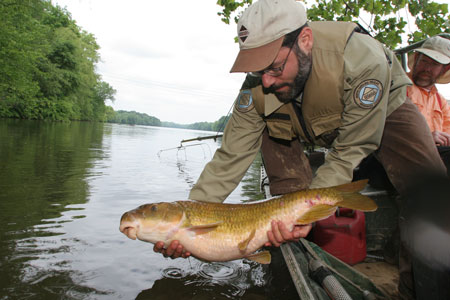Multidisciplinary Research Team Investigates “Mystery Fish” and Health of Pee Dee River Habitat

The robust redhorse—a large, freshwater fish found in only three river systems in the southeastern United States—is very rare, very endangered, and very much the focus of a $460,000 research grant from the U.S. Fish and Wildlife Service involving North Carolina State University and state and federal agencies.
Discovered in North Carolina’s Yadkin River and first described in 1869, the robust redhorse (Moxostoma robustum) remained unknown to scientists until individuals were captured in the Oconee River, Georgia in 1991.
Today wild populations exist in the Ocmulgee and Oconee rivers in Georgia, the Savannah River in Georgia and South Carolina, and the Pee Dee River drainage system in North and South Carolina. Researchers believe the redhorse population in the Pee Dee River has been negatively affected by habitat modification and fragmentation from hydroelectric dams, introduction of non-native species, sedimentation, and water pollution.
The federal grant, which will be matched with $225,400 in state funds, will be used to determine the specific effects that habitat and water quality changes have on the redhorse as well as other fishes, mussels, and crayfish found in the Pee Dee River, which forms at the confluence of the Yadkin and Uwharrie rivers in and flows from North Carolina into South Carolina.
The collaborative research team formed to study the robust redhorse includes Mac Law, a professor of pathology with the Department of Population Health and Pathobiology in NC State University’s College of Veterinary Medicine, whose research specialty involves aquatic animals.
[section_subtitle] Other team members: [/section_subtitle]
- NC State College of Agriculture & Life Sciences
- Tom Kwak , Department of Applied Ecology, Unit Leader, NC Cooperative Fish & Wildlife Research Unit;
- Greg Cope, Department of Applied Ecology;
- Seth Kullman, Department of Biological Sciences;
- Damian Shea, Department of Biological Sciences.
North Carolina Wildlife Resources Commission
- Ryan Heise
South Carolina Department of Natural Resources
- Forrest Sessions
U.S. Fish and Wildlife Service
- Tom Augspurger
According to lead investigator Tom Kwak, the multidisciplinary team of aquatic ecologists, environmental toxicologists, and resource managers will “address complex, contemporary research questions together that none of us could approach individually.”
“Recent research suggests that the impact of emerging contaminants, such as endocrine-disrupting compounds and pharmaceuticals, may be detrimental to fishes and other priority species,” says Ryan Heise, a fisheries research coordinator with the NC Wildlife Resources Commission.
“Some of the chemicals that make it into our waters can mimic the effects of hormones in animals and cause adverse effects,” continues Heise. “After completing this study, we hope to answer questions about the effects of different types of contaminants on robust redhorse and other aquatic animals, which should help us make better management decisions in the future.”
Discovered by naturalist Edward Cope in 1869, the robust redhorse was generally thought extinct and had been lost to science for more than 100 years. Nicknamed the “mystery fish” by researchers, this rare member of the sucker family has been the focus of ongoing research projects to determine the status of existing populations and initiate recovery efforts across the fish’s three-state range Georgia and the Carolinas.
[section_subtitle] About the redhorse. [/section_subtitle]
An adult robust redhorse can grow to 30 inches and weigh 17 pounds. The fish has a thick, robust body with rose-colored fins and a fleshy lower lip. Adults feed only on mussels and clams (bi-valves) and may be an important host fish for some freshwater mussels. With a life span of nearly 30 years, the robust redhorse is considered an indicator species for determining the health of aquatic ecosystems.
[section_subtitle] About the grant [/section_subtitle]
The North Carolina Wildlife Resources Commission was one of agencies in 11 states to receive funding from the U.S. Fish and Wildlife Service through its the State Wildlife Grants (SWG) Program. All SWG-supported projects implement strategies and actions to conserve and recover priority species and habitats identified in the N.C. Wildlife Action Plan.
“The projects funded by these grants target some of the most imperiled species and habitats in the United States,” says Dan Ashe, director of the funding U.S. Fish and Wildlife Service. “These projects are receiving funding because they are tied to well-thought-out conservation plans that identify the highest priority areas where we can make the biggest difference for imperiled species.”

Water pollution from point sources, such as municipal wastewater, contain traditional (pesticides and metals) and emerging (hormones and pharmaceuticals) contaminants that enter the aquatic food web and impact the robust redhorse and other marine and wildlife in the ecosystem. Photo by T.J. Kwak


